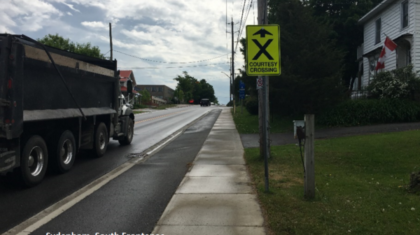

When I first arrived in Hanoi, I was stunned by the seemingly lawless pandemonium of street life in Vietnam’s capital city, which is infamous across the country. Over the course of the three months that I lived there, I reluctantly surrendered to and even began to build a rhythm within the chaos. However, the issue of congestion on Vietnam’s streets and sidewalks has begun to enter public discourse, and the opportunities are many to make the travel experience less hair-raising while preserving the character that makes it so unique, memorable, and oddly functional.
In 2015, I spent a summer supporting GIS and community mapping work at the UN-HABITAT Vietnam office in Hanoi. The work itself was invigorating, but nothing made me feel more alive (and simultaneously at the brink of death) than the daily 10-minute walk from my flat to the office. First, I navigated a series of damp alleys twisting like roots from the nearest major thoroughfare into the heart of the neighborhood, darting to avoid conflict with one two, or three motorbikes abruptly whizzing past. Upon reaching Doi Can, the only major arterial on my journey, the sidewalk experience became treacherous. Don’t look down too long–motorists won’t acknowledge the vertical change demarcating “street” and “sidewalk”, and motorbikes cough up onto the sidewalk at random in search of a place to park. But, don’t look up too long either–your feet will inevitably tangle with half a dozen plastic stools and a open pot of bubbling hot pho, placed by a vendor precisely in the center of the sidewalk to attract the morning commuter crowd. Crossing Doi Can itself was a textbook practice in operationalizing what I found to be the only two observed rules of the road in Vietnam: don’t move too fast, but never, ever stop moving. The accepted strategy is to fake confidence and cross at a slow, steady pace, and the waves of traffic will simply flow around you. The south side of the street offered comparative relief and a return to bustling side streets, and the final phase of my commute was spent weaving through baskets of fresh vegetables spilling out onto the street, throngs of chatting neighbors leaning up against motorbikes or building facades, and an essential stop at my favorite cart for Vietnamese coffee.
Much like its roadways, every square foot of Vietnam’s sidewalks are accounted for. In the United States, planners and designers give much thought to the best approaches for activating shared space. In Vietnam, constant activation is an understatement. The uses along one city block might change a dozen times in one day in a dynamic, unspoken series of time/space economic exchange. People make their living selling a variety of food and merchandise, depending on when you stop by. Neighbors eat family meals. Tourists gawk. Elderly people spread out a blanket and take naps, oblivious to the chaos moving about them. And of course, lots of people park motorbikes.





It is a country in which public space is truly beloved by all. So beloved, in fact, that it is being loved to death. Local officials have begun to scrutinize congestion on Vietnam’s streets and sidewalks, and for good reason: they are discouraging and unsafe, particularly for cyclists, pedestrians and people with ambulatory abilities.
Unfortunately, proposed policy thus far doesn’t seem to address the problem in the right way. Take, for example, Hanoi officials’ unlikely promise to ban all motorbikes from the city center by 2030, without concrete plans to upgrade Vietnam’s transit system within the same time frame. At least, no feasible upgrade that will move the same volume of people as efficiently as motorbikes currently do. Or consider that many cities in Vietnam and across SE Asia have taken to clearing its streets of vendors, levying heavy fines on those who supply the meals, taxi rides and and materials goods that so many others depend on. This approach not only robs vendors of their livelihood; it strips neighborhoods of a distinct character that keeps locals and tourists alike coming back. Anyone who has spent time in SE Asia has probably tried to give a friend directions to your favorite restaurants, only to realize that they were all unnamed, informal assemblages of chairs on street corners.


Discouragingly, a 2010 survey of areas in HCMC found that 41.87% of sidewalk space was taken up not by vendors, but by motorbike parking. This is a conservative number that is likely out of date. The motorbike is likely going nowhere fast. In the meantime, vendors are the most at-risk for removal in order to provide basic accommodation for walking.
Thankfully there are other potential interventions. Separated, protected facilities for pedestrians and cyclists, designated mixed-use sidewalk and curb zones, and positive reinforcement/encouragement programs are all methods that Alta has applied around the globe. Most importantly, these tools help people get where they need to go without leaving anyone out (unlike outright bans on certain modes or activities). Amidst these well-loved corridors we have an incredible opportunity to foster safety and public health, while preserving the aspects of public life that make Vietnam unique.
Thanks for reading. If you enjoyed this article, feel free to hit that clap button ? to help others find it.
Say Hi on Twitter or check out another recent blog featuring bicycle infrastructure experiences in SE Asia.
Can’t get enough? You can even subscribe to our AltaGO Newsletter here.


